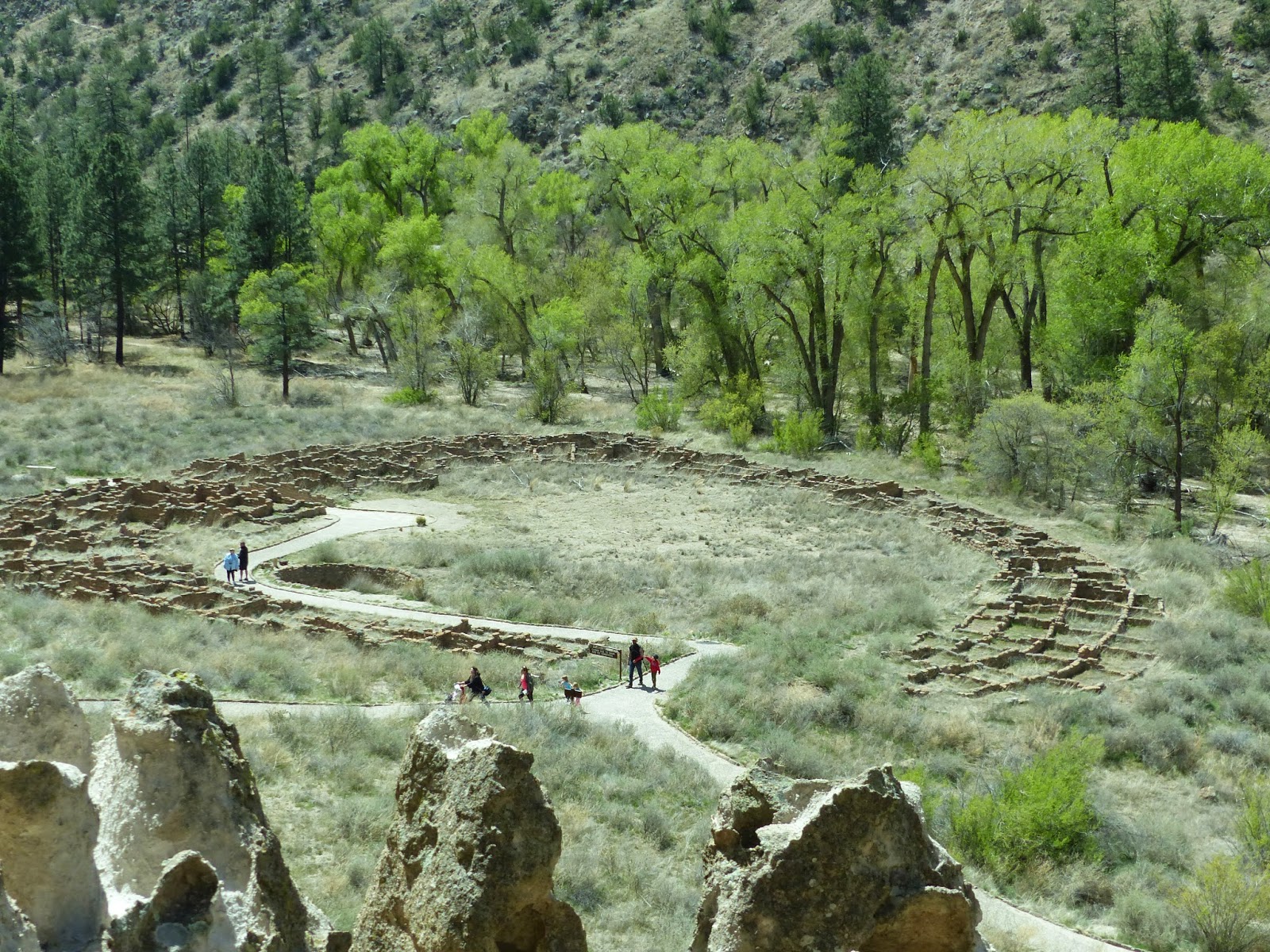 Before you get your expectations up about this being a battlefield, let's get this out of the way right now. A bandolier is "a shoulder-belt with loops or pockets for cartridges". Bandelier National Monument is named after anthropologist Adolph Bandelier, whose work established the foundation for much of modern southwestern archeology.
Before you get your expectations up about this being a battlefield, let's get this out of the way right now. A bandolier is "a shoulder-belt with loops or pockets for cartridges". Bandelier National Monument is named after anthropologist Adolph Bandelier, whose work established the foundation for much of modern southwestern archeology. So the park is about the ancestral pueblo people who lived here until about 500 years ago. Don't cliffs like this just make you want to build a house here? (Assume there's a History Alert. We're talking about pueblos and cliff houses here.)
In the Visitor Center, we watched the video and checked out the exhibit room--which is nowhere as good as the museum at Pecos NM. Then we headed outside to the Main Loop Trail on the way to the cliff dwellings.
Along the way was Frijoles Creek. (In Spanish, that's "little river of beans"--which cracked George up! See? He does have a sense of humor!) Looks pretty benign here, but in September, 2013, they had the largest flood in park history. More on that later.
The Big Kiva is quite a bit larger than the one we saw at Pecos NM. You can see where some of the wooden pillars that supported the roof were. The kiva was the community's center. I think the rectangular openings along the wall might be for ventilation--kivas would be pretty smokey. Even the experts don't know what the rectangular holes in the floor were for. (If you know, please correspond directly with the National Park Service.)
The trail goes right through the village of Tyuonyi. Apparently not everyone liked the high life. The houses were one or two stories high, with about 400 rooms for 100 people. They had three kivas. When we get higher, there will be more pictures of the village to give a better perspective.
As the trail circled towards the cliffs, it started to look interesting. The cliff is made of volcanic tuff, which contrary to it's name is very soft stuff. Ideal for do-it-yourself-cave-makers.We'd already been told we could go into any dwelling that had a ladder. But first, there are stairs to be climbed.
These cave rooms, called cavates by an early archeologist, were dug out of the cliff wall with stone tools. More labor intensive than the homes in the village below, they probably cost more. Inside the lower walls were plastered and painted, and the upper ones were smoke-blackened to keep the volcanic tuff from crumbling.
Talus House was reconstructed for the tourists with no imagination. As you walk the trail in front of the cliff, there are a lot rocks laid in rectangles, so you can often see where they were.
Here's another ladder--that means I get to climb it and go into the cavate. It's a little bigger inside than the last one.
From up here you can get a good view of Tyuonyi village.
So then there are more steps to more ladders to Cave Kiva. This cavate has been reconstructed for us. It's big enough for George to stand up in for a change. The beams near the ceiling were for loom supports, and the little holes in the floor were for anchors to keep the weaving straight. The graffiti is modern and rude. They have to replaster and smoke the kiva on a regular basis to get rid of it.
.JPG)
Of course there were more steps--I'm telling you, touring national parks is not for the faint of heart! Some of the trails and steps were built by the CCC.
Now the trail goes right next to the cliff wall. This series of dwellings is called the "Long House". Here you can see where the outside house foundations are. The parallel holes in the cliff wall were for roof supports. You can see this one had two or three stories.
Question: Did this big chunk of rock fall before or after the houses were built? George thinks it was there a long time before they built the house. I think it crashed down on it. Either way, it sure makes you think.
Count the rows of holes for number of stories. Sometimes people would stand on the top roof and carve petroglyphs into the cliff wall. (They're very hard to see, even life size and in person.)
After leaving the cliff where the Long House was, the trail crossed the creek. There you had the option of going back to the parking lot or turning right to go to the Alcove House. We turned right, heading to the base of that cliff way over there. Then we'll climb a series of four ladders.
George is at the top of the first ladder. You can just barely see the next 3 ladders.
Below, George is waiting for someone to come down Ladder 2 before he can go up. Then you can see what it looks like from the top!
Once you get to the top, you can see the kiva in Alcove House, the size of the alcove, and the roof pole holes by the cavates.
Then it's time to come back down. FYI, the ladders are bolted for us way better than the Indians' ladders were. Can't you just see the little pueblo kids scrambling up and down them? I hung on really tightly.
Oh, yeah--I forgot the caution sign by the first ladder. But now we've been there, done that!
I probably put in too many pictures for this blog posting, but it was kind of fun. If you're really a glutton for punishment, there are more pictures here: Banderlier NM





.JPG)






.JPG)








.JPG)





.JPG)




Post a comment.
Post a Comment
Please leave comments here: